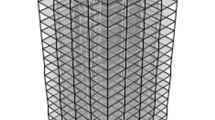Abstract
This paper provides a general perspective of the seismic performance of a nature-inspired, honey-comb grid structural system, known as a hexagrid, under near-field ground motions. Seismic performance of this skeleton is then compared to that of a bundled-tube, as a conventional and efficient load-resisting system in order to provide a better perception of the seismic behavior of a hexagrid skeleton. Two 20-story buildings with bundled-tube and hexagrid skeleton were studied. Nonlinear behavior of the structures was investigated through 3-D finite element computer models and nonlinear time history analyses by subjecting the models to seven three-component records of scaled near-field ground motions. Distribution of peak inter story drift and corner beam-column joint rotations were calculated and compared. Results indicated that by replacing the exterior columns of the bundled-tube system with inclined beam-column elements of nature-inspired hexagons, lateral stiffness of the building increased and it would tolerate less deformations before global dynamic instability is reached. The presence of inclined columns in the hexagrid skeleton helped to concentrate local nonlinearities in ring beams rather than exterior columns.
Similar content being viewed by others
References
Asadi E and Adeli H (2018), “Seismic Performance Factors for Low- to Mid-Rise Steel Diagrid Structural Systems,” The Structural Design of Tall and Special Buildings, 27(15): e1505.
ASCE/SEI 41-13 (2013), Seismic Evaluation and Retrofit of Existing Buildings, American Society of Civil Engineers (ASCE), Virginia, USA.
ATC-72-1 (2010), Modeling and Acceptance Criteria for Seismic Design and Analysis of Tall Buildings, Applied Technology Council, Prepared for Pacific Earthquake Engineering Research Center (PEER), California, USA.
Elnashai AS and Di Sarno L (2008), Fundamentals of Earthquake Engineering, p. 34, New York: Wiley.
Epstein M and Adeeb SM (2008), “The Stiffness of Self-Similar Fractals,” International Journal of Solids and Structures, 45(11–12): 3238–3254.
FEMA 440 (2005), Improvement of Nonlinear Static Seismic Analysis Procedures, Building Seismic Safety Council for the Federal Emergency Management Agency, Washington, D.C., USA.
FEMA P695 (2009), Quantification of Building Seismic Performance Factors, Federal Emergency Management Agency, Washington, D.C., USA.
Fu XY, Gao Y, Zhou Y and Yang X (2012), “Structural Design of Sino Steel International Plaza,” CTBUH 2012 9th World Congress, Shanghai, China.
Gunel MH and Ilgin HE (2007), “A Proposal for the Classification of Structural Systems of Tall Buildings,” Building and Environment, 42(7): 2667–2675.
Hilber HM, Hughes TJ and Taylor RL (1977), “Improved Numerical Dissipation for Time Integration Algorithms in Structural Dynamics,” Earthquake Engineering & Structural Dynamics, 5(3): 283–292.
Kalkan E and Kunnath SK (2006), “Effects of Fling Step and Forward Directivity on Seismic Response of Buildings,” Earthquake Spectra, 22(2): 367–390.
Krawinkler H (2006), “Importance of Good Nonlinear Analysis,” The Structural Design of Tall and Special Buildings, 15(5): 515–531.
Krinitzsky EL and Chang FK (1988), “Intensity-Related Earthquake Ground Motions,” Bulletin of the Association of Engineering Geologists, 25(4): 425–435.
Kurama YC and Farrow KT (2003), “Ground Motion Scaling Methods for Different Site Conditions and Structure Characteristics,” Earthquake Engineering & Structural Dynamics, 32(15): 2425–2450.
Kwan AKH (1994), “Simple Method for Approximate Analysis of Framed Tube Structures,” Journal of Structural Engineering, 120(4): 1221–1239.
Lee HU and Kim YC (2017), “Preliminary Design of Tall Building Structures with a Hexagrid System,” Procedia Engineering, 171: 1085–1091.
Mashhadiali N and Kheyroddin A (2013), “Proposing the Hexagrid System as a New Structural System for Tall Buildings,” The Structural Design of Tall and Special Buildings, 22(17): 1310–1329.
Mashhadiali N and Kheyroddin A (2014), “Progressive Collapse Assessment of New Hexagrid Structural System for Tall Buildings,” The Structural Design of Tall and Special Buildings, 23(12): 947–961.
Mashhadiali N and Kheyroddin A (2019), “Quantification of the Seismic Performance Factors of Steel Hexagrid Structures,” Journal of Constructional Steel Research, 157: 82–92.
Mele E, Di Sarno L and De Luca A (2004), “Seismic Behaviour of Perimeter and Spatial Steel Frames,” Journal of Earthquake Engineering, 8(03): 457–496.
Mele E, Fraldi M, Montuori GM and Perrella G (2016), “Non-Conventional Structural Patterns for Tall Buildings, from Diagrid to Hexagrid and Beyond,” Fifth International Workshop on Design in Civil and Environmental Engineering, October 6–8.
Montuori GM, Fadda M, Perrella G and Mele E (2015), “Hexagrid-Hexagonal Tube Structures for Tall Buildings: Patterns, Modeling, and Design,” The Structural Design of Tall and Special Buildings, 24(15): 912–940.
Nguyen PC and Kim SE (2018), “A New Improved Fiber Plastic Hinge Method Accounting for Lateral-Torsional Buckling of 3D Steel Frames,” Thin-Walled Structures, 127: 666–675.
Parker D and Wood A (2013), The Tall Buildings Reference Book, Routledge.
Pacific Earthquake Engineering Research Center (PEER), PEER Strong Motion Database, http://peer.berkeley.edu/smcat/.
Qu H, Zhang J and Zhao JX (2011), “Strength Reduction Factors for Seismic Analyses of Buildings Exposed to Near-Fault Ground Motions,” Earthquake Engineering and Engineering Vibration, 10(2): 195–209.
Raheem SEA, Zaher AKA and Taha AM (2018), “Finite Element Modeling Assumptions Impact on Seismic Response Demands of MRF-Buildings,” Earthquake Engineering and Engineering Vibration, 17(4): 821–834.
Salgado RA and Guner S (2018), “A Comparative Study on Nonlinear Models for Performance-Based Earthquake Engineering,” Engineering Structures, 172: 382–391.
SAP 2000 (2013), Integrated Software for Structural Analysis and Design, Computers and Structures Inc., Berkeley, California, USA.
Stafford Smith B and Coull A (1991), Tall Building Structures: Analysis and Design, John Wiley and Sons.
Standard No. 2800 (2014), Iranian Code of Practice for Seismic Resistance Design of Buildings, 4th Edition, Building and Housing Research Center, Tehran, Iran.
Author information
Authors and Affiliations
Corresponding author
Rights and permissions
About this article
Cite this article
Kiani, Y.M., Lavassani, S.H.H. & Meshkat-Dini, A. Seismic assessment of nature-inspired hexagrid lateral load-resisting system. Earthq. Eng. Eng. Vib. 20, 661–672 (2021). https://doi.org/10.1007/s11803-021-2045-4
Received:
Accepted:
Published:
Issue Date:
DOI: https://doi.org/10.1007/s11803-021-2045-4




